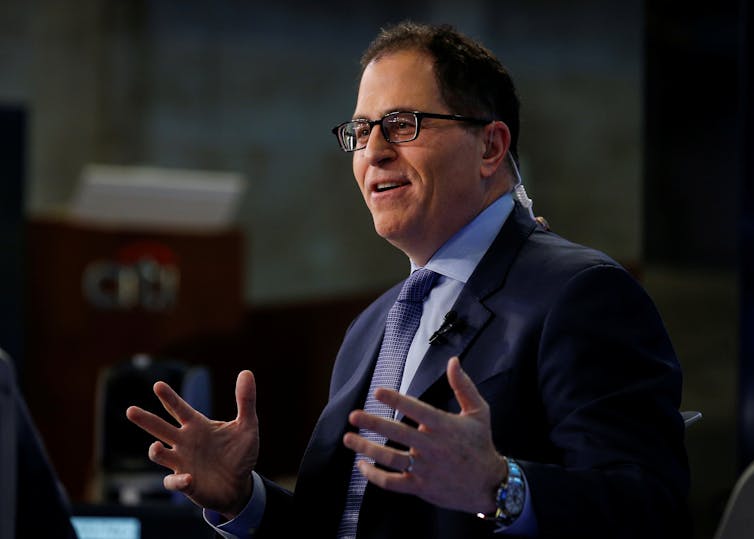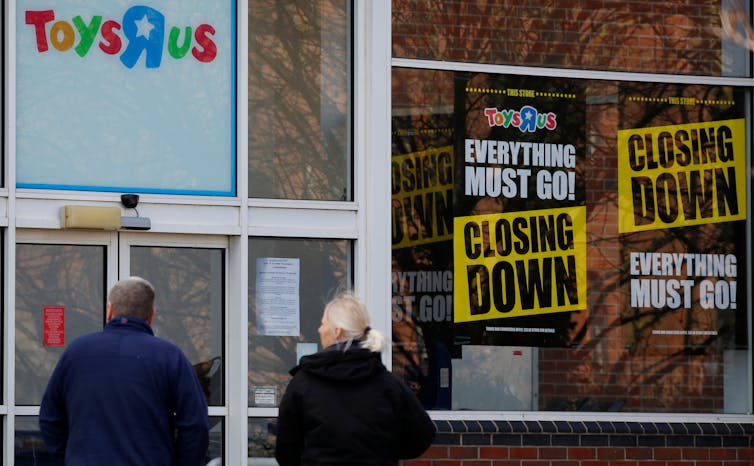Elon Musk was right to drop his bungled plan to take Tesla private
- Written by Erik Gordon, Clinical Assistant Professor, University of Michigan
Elon Musk shocked the world – including his own car company’s board – on Aug. 7 when he tweeted[1] that he had the “funding secured” to take Tesla private. A little more than two weeks of uncertainty[2], confusion and a wildly fluctuating stock price later, the billionaire entrepreneur abruptly called the whole thing off[3].
While he said the reason for the change of heart is that investors urged him to keep Tesla public, Musk could have simply glanced at the history of leveraged buyouts, more commonly known as LBOs.
It is a history replete with both successes[4] that made some people very wealthy and failures[5] that resulted in big losses – as well as bankruptcies and layoffs.
In my experience, as an expert on mergers and acquisitions[6], Tesla’s situation looks more like the failures[7] than the success stories. Nonetheless, Musk’s aborted attempt raises an interesting question: What separates success from failure?
The LBO era begins
While the history[8] of taking a company private goes back to at least to the 1930s, the current chapter relevant to Tesla began in the 1980s when deal makers first began to raise large amounts of debt to buy companies. This era marked the birth of the LBO.
Using debt, or leverage, to raise the funds necessary to buy a company increased the payoff if a deal succeeded – but also the risk of large losses should it fail.
The 1982 acquisition of Gibson Greetings by a group that included former Treasury Secretary William Simon became[9] the archetype for later LBOs. The investors acquired the greeting card company for US$80 million and financed all but $1 million with debt and by selling off its real estate holdings.
It was a huge success for the investors and management. Eighteen months later they re-took the company public with a valuation of over $290 million. Simon alone made $70 million on his investment of less than $350,000, an astonishing 80,000 percent gain in a very short period.
Despite the leverage, the deal was conservative in one important sense: The company generated twice as much cash[10] as it needed in order to meet its debt obligations.
Other successful buyouts, such as Blackstone’s takeover of Hilton Worldwide[11] in 2007 and founder Michael Dell’s buyout of his eponymous computer maker[12] in 2013, also had lots of so-called free cash flow – the cash left over after paying the bills.
As we’ll see, that made all the difference.
 Michael Dell took his eponymous computer company private in 2013.
Reuters/Brendan McDermid[13]
Michael Dell took his eponymous computer company private in 2013.
Reuters/Brendan McDermid[13]
‘Barbarian’ buyouts
Perhaps the most famous LBO ever illustrates the perils of going private.
In 1988, private equity firm KKR bought out RJR Nabisco[14] for $24 billion after an intense bidding war with the tobacco and food conglomerate’s own CEO, Ross Johnson, who started it all by trying to do an LBO of his own.
The classic business book[15] “Barbarians at the Gate” immortalized the deal’s ups and downs and colorful personalities.
But it ended badly[16] for KKR when RJR’s debt burden limited its ability to compete with Philip Morris and makers of low-priced cigarettes[17]. It ended even worse for the 40 percent of the company’s employees who lost their jobs.
Not everyone lost, however. Johnson walked away with $53 million. This led to the typical criticism of LBOs: They make a few people rich but ruin the lives of many others[18].
Great for investors
Academic studies on the success of LBOs have produced differing results, depending on the time period they examine and how they measure success. Overall, they show that buyouts tend to be good for investors but more mixed for employees.
A 2011 study[19] found that LBO investors on average earned over 3 percent per year more than had they simply invested in the Standard and Poor’s 500 from the 1980s through the 2000s.
As for workers, studies indicate[20] that, as a whole, there is little net gain or loss of employment as a result of an LBO. That’s because while about 3 percent of a target’s workforce is cut in the first two years, other jobs are eventually created that make it a wash.
Of course, that is little comfort to the thousands of employees or even tens of thousands who suddenly lose their jobs.
Show me the money
So what separates the LBO winners from the losers?
Recent post-LBO bankruptcies by Texas utility Energy Future Holdings[21] and Toys R Us[22] has put the spotlight on the risks of acquiring too much debt. The $45 billion buyout[23] of Energy Future in 2007 was financed by $37 billion in debt, while Toys R Us has struggled to pay down the more than $5 billion it took on from its 2005 deal.
But that only tells part of the story. Both failures suffered from managerial mistakes and changes to their business environments. Energy Future was clobbered by a drop in energy prices[24]. Executives at Toys R Us failed to adapt[25] to new competitive conditions as retailing moved online.
The key point is that excessive leverage leaves a company vulnerable to a single bad decision, market swoon or other surprise. This is where we come back to the importance of free cash flow. Highly leveraged companies must use a lot of cash to repay debt. That leaves them with little to handle problems or invest in the business.
For example, when RJR Nabisco faced shrinking sales[26], its pile of debt left it with too little cash to battle stiff competition. In other words, debt magnifies the effects of mistakes and twists of fate.
But a company like Gibson with steady or growing free cash flow is more likely to have the money it needs to service its debt and handle surprises. And such a company is more likely to succeed after an LBO.
Tesla is thoroughly in RJR Nabisco’s camp, except infinitely worse. RJR had low debt and capital expenditures[27] and expected to generate over $3.5 billion in free cash flow in the three years after the deal – and that still wasn’t enough. Tesla is burning through every dollar it takes in and more and carries about $10 billion in debt. In 2017 alone, its free cash flow was a negative $4.1 billion[28], which means more cash went out its doors than into its coffers, in part because of significant capital expenditures.
Musk suggested the buyout price tag would be $80 billion. Even if he borrowed only a third of that, that would still require significant amounts of cash to cover interest payments.
 Toys R Us went bankrupt little more than a decade after going private.
Reuters/Phil Noble[29]
Toys R Us went bankrupt little more than a decade after going private.
Reuters/Phil Noble[29]
A charismatic founder
A final distinguishing factor worth noting is whether or not a founder or current manager is part of the group taking the company private.
With Tesla, some investors I’ve spoken to thought that having the charismatic CEO lead the buyout would be a big advantage – and would help offset the risks of too much leverage and not enough cash. They pointed to the success[30] of Dell’s privatization[31] for $24 billion in 2013. But once again, Dell was a cash machine, with over $5 billion in free cash flow at the time of the LBO.
Some research questions[32] the “special” powers of a charismatic CEO, while companies like Macy’s that were taken private by management ended up in bankruptcy[33] as well – with tens of thousands of job losses[34].
When you sum the factors that are likely to lead to LBO success or failure, Musk’s idea to take Tesla private looked bad. Luckily for Tesla stockholders, he wasn’t able to implement it. As history reminds us, some LBOs are better left not done.
References
- ^ he tweeted (twitter.com)
- ^ uncertainty (www.nytimes.com)
- ^ called the whole thing off (www.tesla.com)
- ^ successes (articles.latimes.com)
- ^ failures (archive.fortune.com)
- ^ expert on mergers and acquisitions (theconversation.com)
- ^ failures (www.wsj.com)
- ^ the history (heinonline.org)
- ^ became (www.nytimes.com)
- ^ generated twice as much cash (www.nytimes.com)
- ^ Blackstone’s takeover of Hilton Worldwide (www.bloomberg.com)
- ^ buyout of his eponymous computer maker (dealbook.nytimes.com)
- ^ Reuters/Brendan McDermid (pictures.reuters.com)
- ^ bought out RJR Nabisco (www.businessinsider.com)
- ^ classic business book (www.harpercollins.com)
- ^ it ended badly (archive.fortune.com)
- ^ cigarettes (archive.fortune.com)
- ^ many others (www.rollingstone.com)
- ^ 2011 study (dx.doi.org)
- ^ studies indicate (www.nber.org)
- ^ Energy Future Holdings (www.forbes.com)
- ^ Toys R Us (www.washingtonpost.com)
- ^ $45 billion buyout (dealbook.nytimes.com)
- ^ drop in energy prices (www.wsj.com)
- ^ failed to adapt (www.forbes.com)
- ^ faced shrinking sales (archive.fortune.com)
- ^ expenditures (www.jstor.org)
- ^ negative $4.1 billion (www.marketwatch.com)
- ^ Reuters/Phil Noble (pictures.reuters.com)
- ^ success (www.bloomberg.com)
- ^ privatization (dealbook.nytimes.com)
- ^ Some research questions (hbr.org)
- ^ ended up in bankruptcy (articles.latimes.com)
- ^ job losses (www.apnews.com)
Authors: Erik Gordon, Clinical Assistant Professor, University of Michigan
Read more http://theconversation.com/elon-musk-was-right-to-drop-his-bungled-plan-to-take-tesla-private-102225

